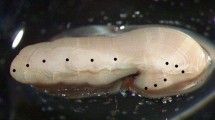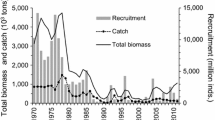Abstract
The spotted flagtail, Kuhlia marginata (Kuhliidae) is commonly found in streams throughout the Ryukyu Archipelago, including Okinawa Island, Japan. Although it has been suggested that they spawn at sea, little is known about their migratory history. The aim of the study was to clarify their migration history based on otolith microchemistry analysis, size composition and the gonadal development of fish collected from the Genka River on Okinawa Island. All strontium/calcium (Sr/Ca) ratios of otoliths remained high around their cores, and then dropped rapidly at some distance from the core. The estimated standard length corresponding to decreases correlated with the size of new recruits collected in the river (ca. 20 mm in standard length: SL). Multiple increases, the sign for migrations into the high saline area, were recognized intermittently around the otolith margin. As the estimated SL at these increases in the Sr/Ca ratio occurred above the minimum maturation size (female: 95.5 mm SL; male: 83.5 mm SL), such multiple increases in Sr/Ca ratios were caused by spawning migration. Therefore, we conclude that the catadromous pattern of K. marginata is as follows; this species grows in the sea during the early life stage until ca. 20 mm SL and then grow in the freshwater area until maturation, before they migrate again to the sea for spawning. Sr/Ca ratio profiles also suggested that a large number of males did not return to the freshwater area after spawning, whereas females might spawn several times during their lives around the inshore area.






Similar content being viewed by others
References
Arai T, Tsukamoto K (1998) Application of otolith Sr:Ca ratios to estimate the migratory history of masu salmon, Oncorhynchus masou. Ichthyol Res 45:309–313
Arai T (2002) Migratory history of fishes: present status and perspective of the analytical methods. Jpn J Ichthyol 49:1–23
Benson LK, Fitzsimons JM (2002) Life history of the Hawaiian fish Kuhlia sandvicensis as inferred from daily growth rings of otoliths. Env Biol Fish 65:131–137
Jordan DS, Tanaka S (1927) The fresh water fishes of the Riukiu Islands, Japan. Ann Carnegie Mus 17:259–278
Kinoshita I (1988) Kuhliidae. In: Okiyama M (ed) An Atlas of the early stage fishes in Japan. Tokai University Press, Tokyo
Limburg KE (1995) Otolith strontium traces environmental history of subyearling American shad Alosa sapidissima. Mar Ecol Prog Ser 119:25–35
Mcdowall RM (1988) Diadromy in fishes, migrations between freshwater and marine environments. Croom Helm, London
Oka S, Tachihara K (2001) Estimation of spawning sites in the spotted flagtail, Kuhlia marginata, based on sperm motility. Ichtyol Res 48:425–427
Otake T, Uchida K (1998) Application of otolith microchemistry for distinguishing between amphidromous and non-amphidromous stocked Ayu, Plecoglossus altivelis. Fish Sci 64(4):517–521
Radtke RL, Kinzie RA (1996) Evidence of a marine larval stage in endemic Hawaiian stream gobies from isolated high-elevation locations. Trans Amer Fish Soc 125:613–621
Randall JE, Randall HA (2001) Review of the fishes of the genus Kuhlia (Perciformes: Kuhliidae) of the Central Pacific. Pac Sci 55(3):227–256
Secor DH, Henderson-Arzapalo A, Piccoli PM (1995) Can otolith microchemistry chart patterns of migration and habitat utilization in anadromous fishes? J Exp Mar Biol Ecol 192:15–33
Secor DH, Ohta T, Nakayama K, Tanaka M (1998) Use of otolith microanalysis to determine estuarine migrations of Japanese sea bass Lateolabrax japonicus distributed in Ariake Sea. Fisher Sci 64(5):740–743
Shen K, Lee Y, Tzeng W (1998) Use of otolith microchemistry to investigate the life history pattern of gobies in a Taiwanese stream. Zool Studies 37(4):322–329
Tsukamoto K (1992) Discovery of spawning area of the Japanese eel. Nature 356:789–791
Yamamoto K, Yamazaki F (1961) Rhythm of development in the oocyte of the gold-fish, Carassius auratus. Fac Fishe, Hokkaido Univ 7(2):93–113
Acknowledgements
We are grateful to former professor S. Shokita (University of the Ryukyus) for critical comments and useful suggestions, and to the staff of the Laboratory of Fisheries Biology and Coral Reef Studies (University of the Ryukyus). We also thank S. Fujita and I. Takahashi for their critical comments. We are much obliged to S. Fukudome, President of Nishinihon Institute of Technology, who encouraged us to undertake the present study. This study was partially supported by the 21st Century COE program of the University of the Ryukyus.
Author information
Authors and Affiliations
Corresponding author
Rights and permissions
About this article
Cite this article
Oka, Si., Tachihara, K. Migratory history of the spotted flagtail, Kuhlia marginata . Environ Biol Fish 81, 321–327 (2008). https://doi.org/10.1007/s10641-007-9203-z
Received:
Accepted:
Published:
Issue Date:
DOI: https://doi.org/10.1007/s10641-007-9203-z




